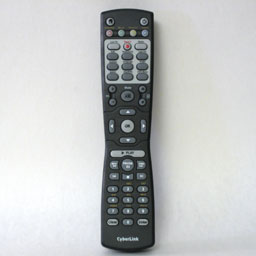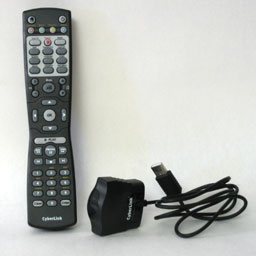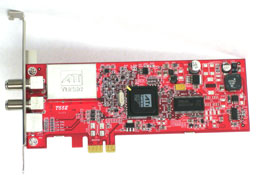HTPC - TV Tuner Reviews
by Jarred Walton on December 7, 2005 12:05 AM EST- Posted in
- Smartphones
- Mobile
PowerColor Theatre 550 Pro PCIe
The last card that we're looking at is quite a bit different from the other two. It's one of the first truly interesting PCI Express X1 cards for home users. (LAN and SATA cards might interest higher end buyers, but most people don't need to worry much about that.) Given the number of boards that are only shipping with two or three PCI slots, plus one to three PCIe X1 slots, it's nice to finally be able to put the PCIe slots to use. Now, if only someone would get around to releasing a PCIe sound card... but I digress. PowerColor is the first to market with a PCIe TV Tuner, based on the ATI Theater 550 (or "Theatre 550" if you prefer the PowerColor/British spelling, though we'll stick with Theater).
The PowerColor card is obviously inferior to the other cards in a few ways. No HDTV support is going to disappoint many people, and no QAM decoding also limits its versatility. As we've mentioned already, though, there's a big difference between doing something, and doing it well. If the analog support on the Theater 550 is clearly superior to that of the other cards, the lack of other features may not matter. We looked at analog TV Tuners several months ago, and in that roundup, the ATI Theater 550 came out on top. With the main difference being PCIe vs. PCI, hopefully we won't see any change in quality.
Something else to consider is that there are no PCIe HDTV tuners at present. With most recent motherboards only including two or three PCI slots, you could put an HDTV tuner in one of those slots and place an analog tuner in an X1 slot. Assuming that you have an add-in sound card, you may not have enough PCI slots to fully accommodate your HTPC needs. The maximum number of supported tuners under Windows MCE is four: two HD and two analog. Most people probably don't go that extreme (and good luck getting a clean signal if you split a coaxial input more than four ways), but it's still something to consider.
Besides the card, you once again get a remote, a USB infrared receiver, and a software bundle. There's also an input cable that allows the use of S-VIDEO or Composite sources, and you get an FM antenna and input. (Radio reception is as bad as OTA TV reception, so I didn't bother trying it. I'm not much of a radio listener anyway.) The remote is definitely more attractive than the Fusion remote, but the MyHD remote is still the smallest of the three. As with the Fusion remote, be careful of the power button, as you can accidentally shut down the PC (or put it in suspend mode) rather than just turning off the software interface. To shut down PowerCinema, you actually press the "Home" button twice. (Duh - as if that's not totally clear....) The placement of the power button on the remote makes it easier to hit, unfortunately, and on several occasions I forgot to use the Home/Power button. Some people may like the feature, but we generally just leave HTPCs running and found it to be more annoying than anything.
The software bundle of the PowerColor card is quite extensive. You get a large selection of CyberLink products with the package, and while several are "Lite" versions, they'll still suffice for most people: PowerDVD, PowerProducer DVD, PowerDirector SE+, Power2Go, MediaShow SE, and PowerCinema. Will you actually need most of that software? Probably not, but it doesn't hurt to have it. Also note that the remote is technically from CyberLink and is made to work with the above software, so if you were to purchase a different Theater 550 card, you would get some other remote. The remote is MCE compliant, though, so you can use it with either interface.
The last card that we're looking at is quite a bit different from the other two. It's one of the first truly interesting PCI Express X1 cards for home users. (LAN and SATA cards might interest higher end buyers, but most people don't need to worry much about that.) Given the number of boards that are only shipping with two or three PCI slots, plus one to three PCIe X1 slots, it's nice to finally be able to put the PCIe slots to use. Now, if only someone would get around to releasing a PCIe sound card... but I digress. PowerColor is the first to market with a PCIe TV Tuner, based on the ATI Theater 550 (or "Theatre 550" if you prefer the PowerColor/British spelling, though we'll stick with Theater).
The PowerColor card is obviously inferior to the other cards in a few ways. No HDTV support is going to disappoint many people, and no QAM decoding also limits its versatility. As we've mentioned already, though, there's a big difference between doing something, and doing it well. If the analog support on the Theater 550 is clearly superior to that of the other cards, the lack of other features may not matter. We looked at analog TV Tuners several months ago, and in that roundup, the ATI Theater 550 came out on top. With the main difference being PCIe vs. PCI, hopefully we won't see any change in quality.
Something else to consider is that there are no PCIe HDTV tuners at present. With most recent motherboards only including two or three PCI slots, you could put an HDTV tuner in one of those slots and place an analog tuner in an X1 slot. Assuming that you have an add-in sound card, you may not have enough PCI slots to fully accommodate your HTPC needs. The maximum number of supported tuners under Windows MCE is four: two HD and two analog. Most people probably don't go that extreme (and good luck getting a clean signal if you split a coaxial input more than four ways), but it's still something to consider.
 |
 |
| Click to enlarge. | |
Besides the card, you once again get a remote, a USB infrared receiver, and a software bundle. There's also an input cable that allows the use of S-VIDEO or Composite sources, and you get an FM antenna and input. (Radio reception is as bad as OTA TV reception, so I didn't bother trying it. I'm not much of a radio listener anyway.) The remote is definitely more attractive than the Fusion remote, but the MyHD remote is still the smallest of the three. As with the Fusion remote, be careful of the power button, as you can accidentally shut down the PC (or put it in suspend mode) rather than just turning off the software interface. To shut down PowerCinema, you actually press the "Home" button twice. (Duh - as if that's not totally clear....) The placement of the power button on the remote makes it easier to hit, unfortunately, and on several occasions I forgot to use the Home/Power button. Some people may like the feature, but we generally just leave HTPCs running and found it to be more annoying than anything.
The software bundle of the PowerColor card is quite extensive. You get a large selection of CyberLink products with the package, and while several are "Lite" versions, they'll still suffice for most people: PowerDVD, PowerProducer DVD, PowerDirector SE+, Power2Go, MediaShow SE, and PowerCinema. Will you actually need most of that software? Probably not, but it doesn't hurt to have it. Also note that the remote is technically from CyberLink and is made to work with the above software, so if you were to purchase a different Theater 550 card, you would get some other remote. The remote is MCE compliant, though, so you can use it with either interface.











77 Comments
View All Comments
JarredWalton - Thursday, December 8, 2005 - link
Just to clarify, I'm speaking of overlay mode in general. The MyHD card overlay mode is limited to 720 x 484 reason. It does hardware decoding, which means it's generating the uncompressed HDTV stream on the card. A 720P compressed signal is up to 15 Mb per second. That presents no problem for the PCI bus. Uncompressed 720P, on the other hand, requires more bandwidth than the PCI bus can handle.1280 x 720 = 921600 pixels per frame
4 bytes per pixel = 3686400 bytes per frame.
60 frames per second = 221184000 bytes per second.
The PCI bus is a 32-bit bus, running at 33 MHz, giving a maximum bandwidth of 133 MB per second. Uncompressed 720P would require about 211 MB per second. This is one of many reasons that the AGP slot was created. The CPU can render into an AGP cards memory at up to 2133 MB per second, at least in theory.
So there is a reason that the my HD card doesn't render the overlay mode in anything more than 720 x 480. That doesn't mean I have to like that limitation. :-)
Crucial - Wednesday, December 7, 2005 - link
I don't understand what the point of this review was. Why would you test a hardware based analog card with 2 cards that have software based analog? The addition of the theatre 550 card was completely unecessary and frankly makes no sense at all.A more effective test would have put the 2 HD cards up against the ATI HDTV wonder and another seperate test putting the 550 against the Hauppage pvr150 and an Avermedia card.
The Boston Dangler - Wednesday, December 7, 2005 - link
Good oneJarredWalton - Wednesday, December 7, 2005 - link
The review was because I had the cards. We've had complaints about putting out single item reviews. We've already looked at the HDTV Wonder, and it doesn't work for me - no QAM support and I don't want to get an expensive OTA antenna for a rental home. The whole article is a "state of the TV Tuner market" as well as individual card reviews, or at least that's how I intended it. Besides, the Theater 550 PCIe is really just a PCIe version of the PCI card we've already looked at, which is good to know.Previous analog tuners have been reviewed, and the ATI HDTV Wonder has also been reviewed. If you can get good OTA DTV reception, you probably have no need for something like the Fusion5 or MyHD. For people like me, though, the choices boil down to forgetting about DTV, getting a DVR upgrade to my cable box, and/or getting one of those two cards.
After playing with all the cards, I would say your best bet for quality is to get two cards, one of analog and a second for DTV.
Ceramicsteve - Wednesday, December 7, 2005 - link
Hey can you include a Mac based HDTV tuner in your round up? The only one I know of is EyETV from Elgato systems and it comes in a form of a breakout box.scott967 - Wednesday, December 7, 2005 - link
I take it none of these tuners support HDCP on the digital out?scott s.
.
JarredWalton - Wednesday, December 7, 2005 - link
That's correct, though I may have screwed up when I talked about my TV. I don't know if it has an HDMI or an HDCP port. I thought it was HDMI, but I could be mistaken.Olaf van der Spek - Wednesday, December 7, 2005 - link
> Using the Sempron 64 running at 2.50 GHz was more than sufficient for everything but the MyHD analog recording.There are no Semprons that run at 2.5 ghz.
JarredWalton - Wednesday, December 7, 2005 - link
I had it overclocked -- I was trying to see if I could get it to work OK for the MyHD card.Olaf van der Spek - Thursday, December 8, 2005 - link
It may be a good idea to mentioned you were overclocking.